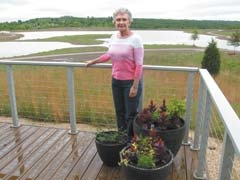Botanical Beauty at Its Best
The Oklahoma Centennial Botanical Garden has 160 acres of Osage Hills prairie and forest which are destined to become one of America’s premier botanical gardens.
By: Joshua Danker-Dake | Category: Recreation/Leisure | Issue: July 2010

Pearl Garrison, director of communications for the Oklahoma Centennial Botanical Garden, stands on the site destined to become one of the country’s premier botanical gardens.
Seven miles northwest of downtown Tulsa, 160 acres of Osage Hills prairie and forest are destined to become one of America’s premier botanical gardens. The Oklahoma Centennial Botanical Garden, open on Saturdays and still a work in progress, will ultimately feature 15 themed gardens, 60 specialty gardens, a 7-acre lake, a conservatory, and a 3,000-seat amphitheater.
“Not many people get the chance to see the beginning of a world-class garden,” says Pearl Garrison, who began volunteering with the garden five years ago and is now its director of communications. “You can come periodically and follow the garden’s development – it’s a unique opportunity. You really have to come out and see it to be able to imagine what it will become.”
The garden site is a combination of hills, open plains and thick forests. “The land the garden is on is cross timbers – where the eastern forest meets the western prairie,” says Garrison. “Of our 160 acres, 60 will be garden and 100 will be used to preserve this unique ecosystem, which features nearly 400 species of plants.” The garden will also prominently feature education and research programs, Garrison says.
Right now, infrastructure is being brought to the site, and the garden is undergoing its first landscaping project: the addition of 300 trees and a walking trail around the lake. The garden is being built methodically and purposely: “We don’t want to rush,” says Garrison. “For a garden of such a high quality, we have to carefully build a solid foundation.” The garden will be further developed as funds are secured.
The garden is now open Saturdays from 10 a.m. to 1 p.m. You can hike the one-and-a-half-mile walking trail through the forest and prairie, which is marked with plant identification signs. The trail around the lake will be opening soon as well. “We have a magnificent natural setting here,” says Garrison. “It’s so quiet and serene; it’s hard to believe we’re only seven miles from downtown Tulsa.”
The vision for the Centennial Botanical Garden began in 1999 with Barry Fugatt, D.C. Coston, Pat Woodrum and Dan Zaloudek. Fugatt, then director of Tulsa’s Master Gardener program, was disappointed that Tulsa didn’t have a world-class garden (Tulsa was, in fact, the only American city of its size without one, Garrison says). A board of directors was formed, and the garden has been in the works ever since.
The land the garden will occupy was donated by a group of investors led by Gentner Drummond and Tom Atherton. According to Garrison, designers from landscape architectural firm MTR were very impressed with the site. The Oklahoma Centennial Commemoration Commission donated $2.2 million for operations and the construction of the lake, road and temporary visitors’ center – these opened in spring of 2008. “The support from the community has been phenomenal,” says Garrison. “We already have over 700 members.”
The garden’s construction will add over $100 million to the local economy, Garrison says, and when it’s completed, it will attract 300,000 visitors a year and add $10 million per year to the economy.
When it’s completed, the Oklahoma Centennial Botanical Garden will be the crown jewel among Tulsa’s many quality gardens. “Tulsa already has so many wonderful gardens – the Philbrook, Gilcrease, Woodward Park, the Linnaeus Garden, and all the great city and county parks. This garden will really help Tulsa become known as a ‘City of Gardens,’” says Garrison.
For more information, including directions to the Oklahoma Centennial Botanical Garden, visit www.ocbg.org. The mailing address is 2 West 6th St., Ste. 325, Tulsa, OK 74119.
For more information, contact
Oklahoma Centennial Botanical Garden
W. 43rd St. N. & N. 52nd W. AveTulsa, OK 74119(918) 289-0330
Oklahoma Centennial Botanical Garden
For more information, contact:
Oklahoma Centennial Botanical Garden
More about Oklahoma Centennial Botanical Garden:
More ArticlesSubscribe
For Free!
